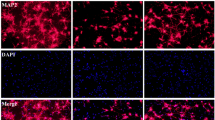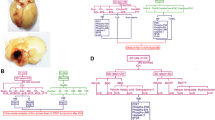Abstract
Neuronal apoptosis after intracerebral hemorrhage (ICH) plays an essential role in neurological deterioration. Preclinical studies have shown that EGb761, an extract of Ginkgo biloba, is neuroprotective in some other neurological diseases with apoptosis. This study was conducted to investigate the potential neuroprotective effect of EGb761 on neuronal apoptosis in experimental ICH. A model of ICH was induced in C57BL/6 mice by injecting collagenase. EGb761 was administered for 21 days and neurologic behaviors were assessed at 1, 3, 7, 14, and 21 days after ICH. RNAi-mediated knockdown of p90 ribosomal S6 kinase 1 (RSK1) was used to further investigate the role of RSK1 in EGb761-induced neuroprotective effects. Neuronal death was determined by TUNEL staining. The image datasets of neurovascular networks were acquired via micro-optical sectioning tomography (MOST). The glycogen synthase kinase-3β (GSK3β) activity was assayed using commercial kit. Primary cultured cortical neurons were exposed to ferrous iron and treated with EGb761. Apoptotic neurons were counted by flow cytometry. RSK1, GSK3β, phosphorylated-GSK3β (pGSK3β), Bcl2, Bax, cleaved-caspase3 (CC3), and VEGF were measured by Western blot. The pGSK3β was also detected by immunofluorescence staining. We found that mice in EGb761 group performed better on rotarod test. Reduced TUNEL-positive neurons and richer microvascular networks were observed in mice treated with EGb761. EGb761 attenuates neuronal apoptosis induced by ferrous iron counted by flow cytometry in vitro. Decreased GSK3β activity was observed in EGb761-treated mice compared with mice with ICH. EGb761 increased the expression of pGSK3β (Ser9), RSK1 and the Bcl2/Bax ratio, and VEGF and decreased CC3 expression. In conclusion, EGb761 reduces neuronal apoptosis and promotes angiogenesis in experimental intracerebral hemorrhage via RSK1/GSK3β pathway.







Similar content being viewed by others
References
Qureshi AI, Mendelow AD, Hanley DF (2009) Intracerebral haemorrhage. Lancet 373(9675):1632–1644
Wilson D, Adams ME, Robertson F, Murphy M, Werring DJ (2015) Investigating intracerebral haemorrhage. BMJ 350:h2484
Qureshi AI, Tuhrim S, Broderick JP, Batjer HH, Hondo H, Hanley DF (2001) Spontaneous intracerebral hemorrhage. N Engl J Med 344(19):1450–1460
Labovitz DL, Halim A, Boden-Albala B, Hauser WA, Sacco RL (2005) The incidence of deep and lobar intracerebral hemorrhage in whites, blacks, and hispanics. Neurology 65(4):518–522
Sudlow CL, Warlow CP (1997) Comparable studies of the incidence of stroke and its pathological types: results from an international collaboration. Stroke 28(3):491–499
Mikulik R, Wahlgren N (2015) Treatment of acute stroke: an update. J Intern Med 278(2):145–165
Gong C, Boulis N, Qian J, Turner DE, Hoff JT, Keep RF (2001) Intracerebral hemorrhage-induced neuronal death. Neurosurgery 48(4):875–882
Mracsko E, Veltkamp R (2014) Neuroinflammation after intracerebral hemorrhage. Front Cell Neurosci 8:388
Xi G, Keep RF, Hoff JT (2006) Mechanisms of brain injury after intracerebral haemorrhage. Lancet Neurol 5(1):53–63
Takahashi-Yanaga F (2013) Activator or inhibitor? GSK-3 as a new drug target. Biochem Pharmacol 86(2):191–199
Chiara F, Rasola A (2013) GSK-3 and mitochondria in cancer cells. Front Oncol 3:16
Kaidanovich-Beilin O, Woodgett JR (2011) GSK-3: functional insights from cell biology and animal models. Front Mol Neurosci 4:40
Vossel KA, Xu JC, Fomenko V, Miyamoto T, Suberbielle E, Knox JA, Ho K, Kim DH et al (2015) Tau reduction prevents Aβ-induced axonal transport deficits by blocking activation of GSK-3β. J Cell Biol 209(3):419–433
Miyawaki T, Ofengeim D, Noh KM, Latuszek-Barrantes A, Hemmings BA, Follenzi A, Zukin RS (2009) The endogenous inhibitor of Akt, CTMP, is critical to ischemia-induced neuronal death. Nat Neurosci 12(5):618–626
Lee HC, Lin YZ, Lai YT, Huang WJ, Hu JR, Tsai JN, Tsai HJ (2014) Glycogen synthase kinase 3 beta in somites plays a role during the angiogenesis of zebrafish embryos. FEBS J 281(19):4367–4383
Romeo Y, Zhang X, Roux PP (2012) Regulation and function of the RSK family of protein kinases. Biochem J 441(2):553–569
Frodin M, Gammeltoft S (1999) Role and regulation of 90 kDa ribosomal s6 kinase (RSK) in signal transduction. Mol Cell Endocrinol 151(1–2):65–77
Stambolic V, Woodgett JR (1994) Mitogen inactivation of glycogen synthase kinase-3 beta in intact cells via serine 9 phosphorylation. Biochem J 303(Pt 3):701–704
Diamond BJ, Bailey MR (2013) Ginkgo biloba: indications, mechanisms, and safety. Psychiatr Clin North Am 36(1):73–83
Janssen IM, Sturtz S, Skipka G, Zentner A, Velasco GM, Busse R (2010) Ginkgo biloba in Alzheimer’s disease: a systematic review. Wien Med Wochenschr 160(21–22):539–546
Weinmann S, Roll S, Schwarzbach C, Vauth C, Willich SN (2010) Effects of Ginkgo biloba in dementia: systematic review and meta-analysis. BMC Geriatr 10:14
Sun BL, Yuan H, Yang MF, Xia ZL, Zhang SM, Wang LX (2007) Effects of extract of Ginkgo biloba on intracranial pressure, cerebral perfusion pressure, and cerebral blood flow in a rat model of subarachnoid haemorrhage. Int J Neurosci 117(5):655–665
Tanaka K, Galduroz RF, Gobbi LT, Galduroz JC (2013) Ginkgo biloba extract in an animal model of Parkinson’s disease: a systematic review. Curr Neuropharmacol 11(4):430–435
Yan M, Liu YW, Shao W, Mao XG, Yang M, Ye ZX, Liang W, Luo ZJ (2016) EGb761 improves histological and functional recovery in rats with acute spinal cord contusion injury. Spinal Cord 54(4):259–265
Sun L, Zhuang W, Xu X, Yang J, Teng J, Zhang F (2013) The effect of injection of EGb761 into the lateral ventricle on hippocampal cell apoptosis and stem cell stimulation in situ of the ischemic/reperfusion rat model. Neurosci Lett 555:123–128
Kwon KJ, Lee EJ, Cho KS, Cho DH, Shin CY, Han SH (2015) Ginkgo biloba extract (EGb761) attenuates zinc-induced tau phosphorylation at ser262 by regulating gsk3beta activity in rat primary cortical neurons. Food Funct 6(6):2058–2067
Sun BL, Hu DM, Yuan H, Ye WJ, Wang XC, Xia ZL, Zhang SM, Wang LX (2009) Extract of Ginkgo biloba promotes the expression of VEGF following subarachnoid hemorrhage in rats. Int J Neurosci 119(7):995–1005
Nada SE, Tulsulkar J, Shah ZA (2014) Heme oxygenase 1-mediated neurogenesis is enhanced by Ginkgo biloba (EGb 761®) after permanent ischemic stroke in mice. Mol Neurobiol 49(2):945–956
Gao X, Lin B, Sadayappan S, Patel TB (2014) Interactions between the regulatory subunit of type I protein kinase a and p90 ribosomal S6 Kinase1 regulate cardiomyocyte apoptosis. Mol Pharmacol 85(2):357–367
Chen J, Tang YX, Liu YM, Chen J, Hu XQ, Liu N, Wang SX, Zhang Y et al (2012) Transplantation of adipose-derived stem cells is associated with neural differentiation and functional improvement in a rat model of intracerebral hemorrhage. CNS Neurosci Ther 18(10):847–854
Chen J, Li Y, Wang L, Zhang Z, Lu D, Lu M, Chopp M (2001) Therapeutic benefit of intravenous administration of bone marrow stromal cells after cerebral ischemia in rats. Stroke 32(4):1005–1011
Li A, Gong H, Zhang B, Wang Q, Yan C, Wu J, Liu Q, Zeng S et al (2010) Micro-optical sectioning tomography to obtain a high-resolution atlas of the mouse brain. Science 330(6009):1404–1408
Wu J, He Y, Yang Z, Guo C, Luo Q, Zhou W, Chen S, Li A et al (2014) 3D brain CV: simultaneous visualization and analysis of cells and capillaries in a whole mouse brain with one-micron voxel resolution. NeuroImage 87:199–208
Pei L, Shang Y, Jin H, Wang S, Wei N, Yan H, Wu Y, Yao C et al (2014) DAPK1-p53 interaction converges necrotic and apoptotic pathways of ischemic neuronal death. J Neurosci 34(19):6546–6556
Liu D, Wei N, Man HY, Lu Y, Zhu LQ, Wang JZ (2015) The MT2 receptor stimulates axonogenesis and enhances synaptic transmission by activating Akt signaling. Cell Death Differ 22(4):583–596
Chen J, Regan RF (2004) Heme oxygenase-2 gene deletion increases astrocyte vulnerability to hemin. Biochem Biophys Res Commun 318(1):88–94
Chen-Roetling J, Chen L, Regan RF (2009) Minocycline attenuates iron neurotoxicity in cortical cell cultures. Biochem Biophys Res Commun 386(2):322–326
Pei L, Wang S, Jin H, Bi L, Wei N, Yan H, Yang X, Yao C et al (2015) A novel mechanism of spine damages in stroke via DAPK1 and tau. Cereb Cortex 25(11):4559–4571
Qu N, Zhou XY, Han L, Wang L, Xu JX, Zhang T, Jiang C, Qiao C et al (2016) Combination of PPT with LiCl treatment prevented bilateral ovariectomy-induced hippocampal-dependent cognition deficit in rats. Mol Neurobiol 53(2):894–904
Tang T, Liu XJ, Zhang ZQ, Zhou HJ, Luo JK, Huang JF, Yang QD, Li XQ (2007) Cerebral angiogenesis after collagenase-induced intracerebral hemorrhage in rats. Brain Res 1175:134–142
Arai K, Jin G, Navaratna D, Lo EH (2009) Brain angiogenesis in developmental and pathological processes: neurovascular injury and angiogenic recovery after stroke. FEBS J 276(17):4644–4652
Seto SW, Chang D, Jenkins A, Bensoussan A, Kiat H (2016) Angiogenesis in ischemic stroke and angiogenic effects of Chinese herbal medicine. J Clin Med 5(6). doi:10.3390/jcm5060056
Acknowledgements
This investigation was supported by Prof. Zhouping Tang’s National Natural Science Foundation of China (81171089, 81471211). We would like to express our gratitude to Dr. Teng Zhang for his assistance in this experiment.
We are very grateful to Wuhan Oebio Biology Co., Ltd. (http://www.oebio.com/) for kindly assisting us with the MOST technique used in the reconstruction of 3D neurovascular networks. Ginkgo biloba (EGb761) was kindly provided by Dr. Willmar Schwabe Pharmaceuticals, Germany.
Authors’ Contributions
Chao Pan performed most of the experiments and drafted the manuscript; Na Liu and Ping Zhang conducted the neuronal culture studies; Qian Wu performed the flow cytometry; Hong Deng established the animal models; Feng Xu bred the mice and conducted the behavioral tests; Lifei Lian and Qiming Liang performed the Western blot; Yang Hu conducted the statistical analysis; and Prof. Zhouping Tang and Suiqiang Zhu designed and guided the experiments.
Author information
Authors and Affiliations
Corresponding authors
Ethics declarations
Conflict of Interest
The authors declare that they have no competing interests.
Glossary
- AD
-
Alzheimer’s disease
- CC3
-
Cleaved-caspase3
- GSK3β
-
Glycogen synthase kinase-3β
- ICH
-
Intracerebral hemorrhage
- mNSS
-
Modified neurological severity score
- MOST
-
Micro-optical sectioning tomography
- PD
-
Parkinson’s disease
- pGSK3β
-
Phosphorylated-GSK3β
- PI
-
Propidium iodide
- RNAi
-
RNA interference
- RSK1
-
p90 ribosomal S6 kinase 1
- SAH
-
Subarachnoid hemorrhage
Rights and permissions
About this article
Cite this article
Pan, C., Liu, N., Zhang, P. et al. EGb761 Ameliorates Neuronal Apoptosis and Promotes Angiogenesis in Experimental Intracerebral Hemorrhage via RSK1/GSK3β Pathway. Mol Neurobiol 55, 1556–1567 (2018). https://doi.org/10.1007/s12035-016-0363-8
Received:
Accepted:
Published:
Issue Date:
DOI: https://doi.org/10.1007/s12035-016-0363-8




